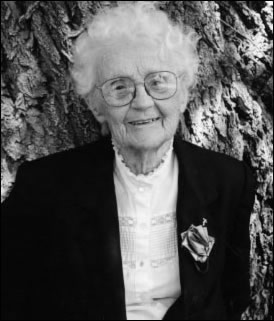Santa Fe Living Treasures – Elder Stories
<<Back to Treasures Index Myrtle White RomeroSHE FOUND HER PLACE ALONG THE RIO GRANDEHonored October, 1999 | Myrtle White RomeroWhen Myrtle White Romero was a young girl in her native Kansas, her father was murdered. The family was plunged into poverty, and her mother took in washing to hold it together. Myrtle knew she had to pay her own way, as well as help the family, so at 11 she left home to care for some neighbors’ children. At 14 she became a housekeeper for a man and his wife. Yet none of the hardship was enough to quench her indomitable spirit. Seeking adventure, she arrived in New Mexico in 1929 aboard a Fred Harvey bus. She found a teaching job at the little missionary school in Velarde, a school that through the years grew into the impressive McCurdy School in Española. Soon the pretty young teacher caught the eye of a local man, Carlos Romero, who sang in the church choir. They married in 1930, and had two daughters by 1934. The Depression was hard on the family, and Myrtle returned to Kansas to complete work on a teaching certificate that would qualify her to work in the public-school system. Then she came back to Velarde. Myrtle’s husband did not enjoy farming, but with almost no job opportunities he did his best at it. Then World War II brought the top-secret Manhattan Project to Los Alamos, and he found work as a carpenter there. But at about the same time he did, Myrtle turned 50 in 1942, and decided she wanted to pursue a new course in her life. Her daughters were married by then, and had given Myrtle and Carlos some grandchildren. But a grandson named Ray developed leukemia. He was treated at the medical lab in Los Alamos, but the disease, which was almost always fatal in that era, killed him. In her sadness, Myrtle decided to become a lab technician to help fight cancer. When she tried to follow through, however, she found that no school would train anyone over the age of 45. Frustrated, she discussed the situation with the head of medical research at Los Alamos. He was impressed, and said he would train her himself. She became proficient in hematology and cytology, and passed her registry exams. Until 1969 she worked as a technician. But she left the job when her ill mother moved here. After her mother’s death in 1973, Myrtle began to jot down her reflections about life along the Rio Grande. She showed her work to the editor of the weekly Rio Grande Sun in Española, and he was sufficiently impressed to offer her a column for which she would be paid $2.50 a week. It was the start of her third career. Her column won prizes in journalism contests, and came to the attention of Smithsonian Magazine, which in 1996 featured her prominently in an article about the residents of Velarde. She continued her “Housewife by the Rio Grande” column--full of tips, recipes, musings and stories--until 1999. But then she quit--even though by that time her pay had been raised to $7.50. “I just decided that, at 91, I was tired of writing,” she explained. “I just didn’t want to drag that heavy typewriter out to my kitchen table anymore.” In retirement Myrtle remained active in the Velarde United Methodist Church, where she was married, and she has been a generous volunteer and piano player at the Hacienda del Salud Nursing Home. There she likes to visit “elderly friends,” some of whom are 30 years her junior. But at night she returns to the home that she and her husband built in the 1930s. She still does housework, but now refuses to mow the lawn. Her greatest pleasure at this time in her life is her extensive family, with many members living nearby. There are eight grandchildren and 10 great-grandchildren. And Myrtle likes to remind them wisely: “Doors close, doors open.”
|
